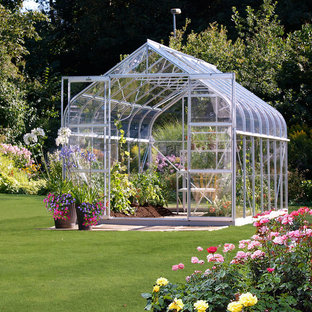DIY: How to build a greenhouse
- Nov 15, 2020
- 5 min read
Nothing tastes better than vegetables fresh from the garden but vermin, cold and rain can considerably reduce your harvest. Making a greenhouse is a good solution because you have a vastly improved microclimate, you can control the irrigation and you’ll be keeping snails and birds well away from your crops. Plastics such as Polycarbonate are popular greenhouse material because of their strength and impact resistance. They can be used not only to build carports, terrace canopies or windbreaks but also rock-solid greenhouses. Do you have green fingers and a few basic handy skills? If so, you can easily make a garden greenhouse using extremely strong polycarbonate glazing. The design is completely up to you, we give you the most important tips on the construction and the placement of the plastic glazing in your greenhouse.
Materials required for making your own greenhouse:
Hardwood ground posts
Hardwood poles for the foundation
Timber (spruce) beams for the side walls (at least 2in x 1.5in)
Corner brackets
Stainless steel screws
Aluminum U and H profiles
Concrete (for pouring in the ground posts)
Fret bolts 1/2 in
Drills 5, 9, 12 mm
Screws with a countersunk head, 3-4 mm
Screws with a flat head, 3-4 mm
Step 1: Decide on the location and the dimensions
It goes without saying that your greenhouse will require a sunny spot, but you should also take the effect of wind force on your greenhouse into account. A greenhouse has a large vertical surface and plastic sheets are fairly light. This means that even a slight breeze places a strong load on the basic structure of your greenhouse. If your greenhouse is in a windy spot, you will have to anchor it firmly: a solid foundation is always essential, even if your greenhouse is in the lee.
The dimensions are determined by two factors: the space of the pitch and the dimensions of a full sheet. A full sheet of polycarbonate is 96 inches long and 48 inch wide. Most greenhouses panels have a ridge height of 36 - 48 inches, the vertical sides are usually around 8 feet high not including the roof.
You are free to decide on the dimensions of the short wall: for example, you can cut a full sheet in strips of 3-4ft wide. If you make one strip hinged, you have a nice size for a door.
Step 2: Lay the anchorage and the foundation of the greenhouse.
There are various techniques for anchoring and building the foundation for your construction but not every handyman has the necessary materials and tools. That is why we limit ourselves to materials that are available at every hardware store: timber and hardware. You make the foundation from hardwood poles of 2.25in by 2.25. With the help of corner brackets or angle irons, you screw the foundation stakes into a rectangle and place this in your chosen position.
Next, place the anchoring in the ground. For this, we use six hardwood stakes 30 inches long. Four stakes are located within the corners of the foundation, the remaining two are halfway along the longer side. Then place the stakes as far as possible in the ground, the heads protrude a maximum of 2 1/2 inch (the width of the foundation piles) above the ground. If the heads protrude too far, you can cut them to size later. You can also dig out the holes and set the piles into concrete, this is even stronger than piles in the ground.
The foundation is fixed to the ground posts with 5 inch fret bolts. The holes in the hardwood must be pre-drilled, start with a drill of 2 inches followed by a drill of 4 inches. Finally, drill a
4 3/4 hole through the foundation beams only. Drill one mounting hole at a time. Secure the foundation beams at one angle with a fret bolt and use a spirit level to determine the next borehole / mounting point.
Step 3: Setting up the side walls
With the help of corner brackets, screw the vertical uprights onto the foundation poles of the longer side. Place the uprights opposite each other on the left and right side of the greenhouse. These two uprights connect to each other at the top with a corner bracket and a crossbeam, so they can’t fall inwards. When all the uprights are mounted, you temporarily screw a longitudinal girder along the sleepers. Now the skeleton of your greenhouse has the necessary strength and you can continue with the installation of the plastic windows.
We will place the windows in aluminum U-profiles, which are available at every DIY store. At the bottom of the profile, there are usually screw holes with which you can easily screw the profile to the uprights. At the corners, you miter the profiles so that they fit together neatly. Then unscrew the U-profiles on the foundation beam and against the vertical uprights. Use all the screw holes in the profiles because of the strength! You can finish off the profiles with foam tape against the inside and outside of the profile, this prevents the windows flapping. We are going to finish the windows with kit anyway, this normally helps to prevent flapping.
Now we can place the windows. Carefully lower them into the profiles from above. If there is a little bit of a breeze, you will notice that the wind exerts a lot of force on the construction. That is why we are working quickly to finish off and reinforce the greenhouse.
Step 4: Set up the roof construction
The design of the roof is entirely up to you. You can choose to make a traditional pointed roof, a pitched roof or just a flat roof. The roof structure is supported by a beam that lies on top of the vertical uprights of the longer side. This beam is called the wall plate, this wall plate is sawn with a miter. The angle of the miter corresponds to the roof slope. The flat side of the wall beam is on the uprights, the roof trusses are placed on the sloping side. The miter of the wall plate thus depends on the type of roof and the roof pitch: it’s wise to calculate this in advance. You can have beams cut lengthwise with a miter at any hardware store.
The wall plate lies on top of the vertical poles and is screwed to them using corner brackets. You can build the rest of the roof structure in the same way. If you opt for a traditional greenhouse shape, you also have to include a rider in the construction. This is a beam on which the cover over the roof corner is mounted. It is advisable to make a part of the roof hinged, then you can open a section if the temperature gets too high.
A wide range of brackets is available at builders’ merchants, giving you the freedom to design a roof construction yourself. The most important point, however, is the installation of the polycarbonate twin-wall roofing sheets on your greenhouse, which differs from the installation of the glazing.
Step 5: Placing the roof of the greenhouse
The roof isn’t mounted in U-profiles but is screwed directly onto the wood. As the material for the roof, we advise you to choose polycarbonate (channel) plates. This sheet material is extremely strong, the risk of breakage by hail or flying branches is zero. All screw holes in the plate must be pre-drilled, drill a screw hole every 6 inches . Do not use countersunk screws for screwing, but ordinary flat screws, this prevents tearing when tightening. If you mount two plates next to each other, use an H-profile between both plates to ensure a seamless connection. If all roofing sheets have been placed, you can start finishing.
If you have opted for a traditional greenhouse style, with two sloping roof halves, you have to finish the ridge with a ridge cover to prevent rain from getting in the top. Then you seal all edges: the open sides of the channel plates, the edges along the H-sections and the edges along the ridge. Finally, you also seal the seams along the glazing. Your greenhouse is now ready for use. You only have to install a floor and a row of tiles on which you can walk.






